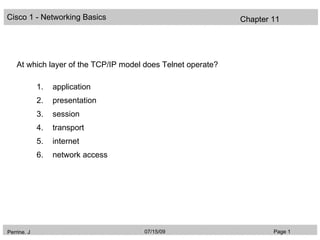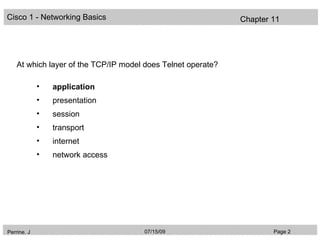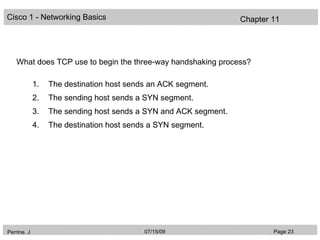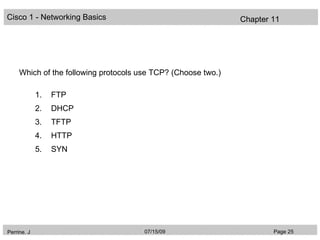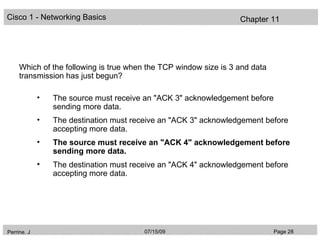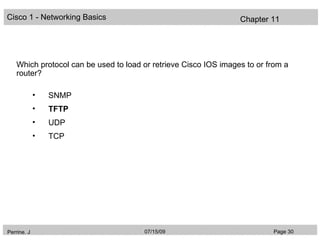Q1 On Ch11 Tcpip And Application Layer
- 1. Cisco 1 - Networking Basics Chapter 11 At which layer of the TCP/IP model does Telnet operate? 1. application 2. presentation 3. session 4. transport 5. internet 6. network access Perrine. J 07/15/09 Page 1
- 2. Cisco 1 - Networking Basics Chapter 11 At which layer of the TCP/IP model does Telnet operate? • application • presentation • session • transport • internet • network access Perrine. J 07/15/09 Page 2
- 3. Cisco 1 - Networking Basics Chapter 11 Which of the following SNMP components would a router be considered? 1. network management system 2. agents 3. managed devices 4. secure ports Perrine. J 07/15/09 Page 3
- 4. Cisco 1 - Networking Basics Chapter 11 Which of the following SNMP components would a router be considered? • network management system • agents • managed devices • secure ports Perrine. J 07/15/09 Page 4
- 5. Cisco 1 - Networking Basics Chapter 11 Which SNMP component is responsible for using the majority of memory resources? 1. network management system 2. agents 3. managed devices 4. secure ports Perrine. J 07/15/09 Page 5
- 6. Cisco 1 - Networking Basics Chapter 11 Which SNMP component is responsible for using the majority of memory resources? • network management system • agents • managed devices • secure ports Perrine. J 07/15/09 Page 6
- 7. Cisco 1 - Networking Basics Chapter 11 Which protocol is used by e-mail servers to communicate with each other? 1. FTP 2. HTTP 3. TFTP 4. SMTP 5. POP 6. SNMP Perrine. J 07/15/09 Page 7
- 8. Cisco 1 - Networking Basics Chapter 11 Which protocol is used by e-mail servers to communicate with each other? • FTP • HTTP • TFTP • SMTP • POP • SNMP Perrine. J 07/15/09 Page 8
- 9. Cisco 1 - Networking Basics Chapter 11 Which part of the URL http://www.awsb.ca/teacher gives the name of the domain? 1. www 2. http:// 3. /teacher 4. awsb.ca Perrine. J 07/15/09 Page 9
- 10. Cisco 1 - Networking Basics Chapter 11 Which part of the URL http://www.awsb.ca/teacher gives the name of the domain? • www • http:// • /teacher • awsb.ca Perrine. J 07/15/09 Page 10
- 11. Cisco 1 - Networking Basics Chapter 11 Which of the following are disadvantages of using SMTP for e-mail servers? (Choose two.) 1. offers very little security 2. no authentication 3. strong reliability 4. does not work well with email servers Perrine. J 07/15/09 Page 11
- 12. Cisco 1 - Networking Basics Chapter 11 Which of the following are disadvantages of using SMTP for e-mail servers? (Choose two.) • offers very little security • no authentication • strong reliability • does not work well with email servers Perrine. J 07/15/09 Page 12
- 13. Cisco 1 - Networking Basics Chapter 11 Which of the following are components of SNMP? (Choose three.) 1. network management system 2. protocol analyzer 3. managed devices 4. secure ports 5. agents 6. protocol inspector Perrine. J 07/15/09 Page 13
- 14. Cisco 1 - Networking Basics Chapter 11 Which of the following are components of SNMP? (Choose three.) • network management system • protocol analyzer • managed devices • secure ports • agents • protocol inspector Perrine. J 07/15/09 Page 14
- 15. Cisco 1 - Networking Basics Chapter 11 Which of the following uses a connectionless protocol to transfer files? 1. FTP 2. TFTP 3. HTTP 4. SNMP Perrine. J 07/15/09 Page 15
- 16. Cisco 1 - Networking Basics Chapter 11 Which of the following uses a connectionless protocol to transfer files? • FTP • TFTP • HTTP • SNMP Perrine. J 07/15/09 Page 16
- 17. Cisco 1 - Networking Basics Chapter 11 Which type of institution does the domain suffix .org represent? 1. government 2. education 3. network 4. non-profit Perrine. J 07/15/09 Page 17
- 18. Cisco 1 - Networking Basics Chapter 11 Which type of institution does the domain suffix .org represent? • government • education • network • non-profit Perrine. J 07/15/09 Page 18
- 19. Cisco 1 - Networking Basics Chapter 11 Which protocol is used by FTP to transfer files over the Internet? 1. TCP 2. SMTP 3. UDP 4. SNMP Perrine. J 07/15/09 Page 19
- 20. Cisco 1 - Networking Basics Chapter 11 Which protocol is used by FTP to transfer files over the Internet? • TCP • SMTP • UDP • SNMP Perrine. J 07/15/09 Page 20
- 21. Cisco 1 - Networking Basics Chapter 11 Which TCP/IP layer is responsible for dialog control? 1. application 2. presentation 3. session 4. transport Perrine. J 07/15/09 Page 21
- 22. Cisco 1 - Networking Basics Chapter 11 Which TCP/IP layer is responsible for dialog control? • application • presentation • session • transport Perrine. J 07/15/09 Page 22
- 23. Cisco 1 - Networking Basics Chapter 11 What does TCP use to begin the three-way handshaking process? 1. The destination host sends an ACK segment. 2. The sending host sends a SYN segment. 3. The sending host sends a SYN and ACK segment. 4. The destination host sends a SYN segment. Perrine. J 07/15/09 Page 23
- 24. Cisco 1 - Networking Basics Chapter 11 What does TCP use to begin the three-way handshaking process? • The destination host sends an ACK segment. • The sending host sends a SYN segment. • The sending host sends a SYN and ACK segment. • The destination host sends a SYN segment. Perrine. J 07/15/09 Page 24
- 25. Cisco 1 - Networking Basics Chapter 11 Which of the following protocols use TCP? (Choose two.) 1. FTP 2. DHCP 3. TFTP 4. HTTP 5. SYN Perrine. J 07/15/09 Page 25
- 26. Cisco 1 - Networking Basics Chapter 11 Which of the following protocols use TCP? (Choose two.) • FTP • DHCP • TFTP • HTTP • SYN Perrine. J 07/15/09 Page 26
- 27. Cisco 1 - Networking Basics Chapter 11 Which of the following is true when the TCP window size is 3 and data transmission has just begun? 1. The source must receive an "ACK 3" acknowledgement before sending more data. 2. The destination must receive an "ACK 3" acknowledgement before accepting more data. 3. The source must receive an "ACK 4" acknowledgement before sending more data. 4. The destination must receive an "ACK 4" acknowledgement before accepting more data. Perrine. J 07/15/09 Page 27
- 28. Cisco 1 - Networking Basics Chapter 11 Which of the following is true when the TCP window size is 3 and data transmission has just begun? • The source must receive an "ACK 3" acknowledgement before sending more data. • The destination must receive an "ACK 3" acknowledgement before accepting more data. • The source must receive an "ACK 4" acknowledgement before sending more data. • The destination must receive an "ACK 4" acknowledgement before accepting more data. Perrine. J 07/15/09 Page 28
- 29. Cisco 1 - Networking Basics Chapter 11 Which protocol can be used to load or retrieve Cisco IOS images to or from a router? 1. SNMP 2. TFTP 3. UDP 4. TCP Perrine. J 07/15/09 Page 29
- 30. Cisco 1 - Networking Basics Chapter 11 Which protocol can be used to load or retrieve Cisco IOS images to or from a router? • SNMP • TFTP • UDP • TCP Perrine. J 07/15/09 Page 30
